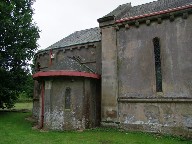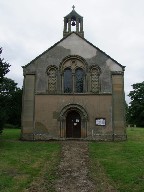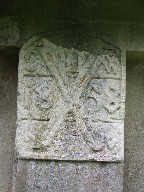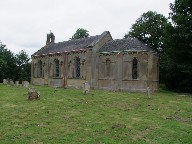| |
|
St
Andrew, South Runcton I must have passed this lonely
little church dozens of times without realising it was
here. It is spectacularly poorly placed, set screened by
trees immediately above the busy Downham market to Kings
Lynn road. This made sense in the 1880s, when it was
built, but today the traffic storms past, and it is
difficult enough to stop for a moment, let alone to
actually park.
19th
century Romanesque is rarely good, but there is something
rather pleasing about St Andrew, its cupola-crowned
frontage reminiscent of something you might find more
easily in the backhills of Burgundy rather than in an
East Anglian field. The architect was John Brown of the
Norwich Diocese, and the date was 1839 - that is to say,
this was one of Norfolk's first Victorian churches. Brown
is an interesting architect, because he was busy just
before the Ecclesiological Movement set out the rules for
a 'proper' restoration. Norwich was the see of the
forward-thinking Bishop Bathurst, and we may imagine that
Brown had plenty of freedom. By the second half of the
century, mock-Norman had become laughable, but John
Brown, working on the cusp of Georgian and Victorian
taste, managed to produce a number of churches in the
county that are of interest and originality, in an idiom
which he made his own.
| In
this case, he was replacing a genuine Norman
church on the same site, and actually retained
the lower part of the chancel arch. The arcading
down the south side creates a grand effect, but
is curiously not repeated on the north side.
Brown thought a Norman church should have an
apse, and so he gave it one. A later addition, a
rather awkward little vestry on the north side of
the apse, has a plaque with the cross of St
Andrew and the date 1858. As you
might expect for this part of Norfolk, the church
is kept locked and there is no keyholder notice.
Quite frankly, I think this is asking for
trouble. It would make much more sense to remove
all valuables and leave the church open all the
time. As it is, this is such a remote spot and is
so screened from the road that they are bound to
get break-ins.
It
hasn't always been the case that St Andrew was
locked to strangers and pilgrims. As at Runcton
Holme nearby, there is a notice on the door
telling you to Come in and Pray, which
briefly made me optimistic. But the notice is
faded, as if praying in a church were no longer
fashionable, or even thought particularly
necessary. A newer notice beneath it proclaims
that the church has No Safe, No Silver, No
Money, while a third notice above observes
that all children are welcome at our worship,
rather wistfully I thought. Looking through a
window, we saw that the sills were decorated with
silk flowers, and the building was full of light.
It seemed an attractive space, and I wished it
had more to offer than just being a fortress, or
a venue for the Sunday club.
|
|
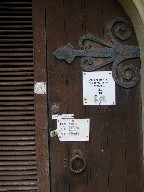 |
|
|
|

